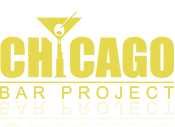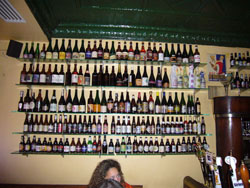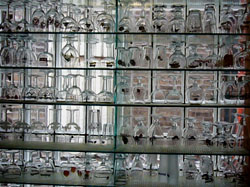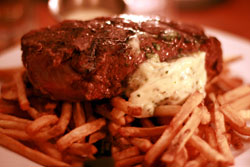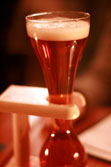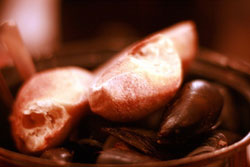“Friendliest bar on the North Side”
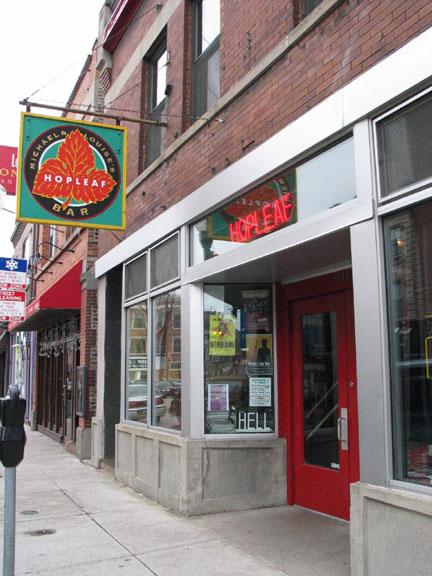 The secret is out: one of the best neighborhood taverns in Chicago is not in Lincoln Park, Bucktown or even Lakeview. It’s in the far north Chicago hamlet of Andersonville, and its name is Hopleaf Bar. Locals know it simply as “Hopleaf” and desperately try to guard its eroding anonymity from those bar-hopping further south. Even though the weekend crowds pack the place, Hopleaf remains true to its design as a cool neighborhood joint that draws a loyal and increasing following from its laid-back vibe, tasteful decor, eclectic music, the best steamed mussels in the city, a most pleasant outdoor beer garden, and one of the best hop selections in the city with 41 beers on tap—mostly of the Belgian variety, including multiple trappist ales—and over 260 craft brews and imports in bottles. If that wasn’t enough, Hopleaf is also one of the first gastropubs in the entire country when it opened its kitchen in 2003, helping to spur the Gastropub Revolution?
The secret is out: one of the best neighborhood taverns in Chicago is not in Lincoln Park, Bucktown or even Lakeview. It’s in the far north Chicago hamlet of Andersonville, and its name is Hopleaf Bar. Locals know it simply as “Hopleaf” and desperately try to guard its eroding anonymity from those bar-hopping further south. Even though the weekend crowds pack the place, Hopleaf remains true to its design as a cool neighborhood joint that draws a loyal and increasing following from its laid-back vibe, tasteful decor, eclectic music, the best steamed mussels in the city, a most pleasant outdoor beer garden, and one of the best hop selections in the city with 41 beers on tap—mostly of the Belgian variety, including multiple trappist ales—and over 260 craft brews and imports in bottles. If that wasn’t enough, Hopleaf is also one of the first gastropubs in the entire country when it opened its kitchen in 2003, helping to spur the Gastropub Revolution?
Since the idea was conceived in the early 1960s, Andersonville has quietly become one of Chicago’s most popular neighborhood enclaves. The area is clean, gang-free, easily accessible to the Loop (thanks to Lake Shore Drive and Clark Street buses), and has a unique character due to its Swedish roots and recent influence of older LGBTQ+ couples migrating from Boystown further south. The result is an interesting mix of kitschy boutiques, excellent restaurants like the original location of both Ann Sather’s Restaurant and Reza’s (Mediterranean), and notable imbiberies that include Simon’s and Konak.
Opened in 1992, Hopleaf is located near the corner of Clark and Winona Street, just south of Foster Avenue. To find it, keep your eye out for the modest, hand-made Hopleaf sign depicting the three-leafed hop plant, or the smallish red neon Hopleaf sign both above the wooden door with plate glass. The best way to get there is via cab unless you don’t mind a long walk from the Lawrence El stop on the Red Line or the slow boat to China, otherwise known as the Clark Street #22 bus. If you cab it, don’t worry. Just because it’s way up north you’ll be able to find one going back south, which makes it easy to head directly over to the Lakeview Lounge, Carol’s Pub or Nick’s Uptown for some late-night action.

Photo courtesy of Andrew M. Beauty in simplicity. Some of the best bars in this great city of Chicago are those that offer a good pint in a comfortable setting, and not much more. The Charleston, Four Moon Tavern and Jake’s Pub are prime examples of this and the Hopleaf fits right in with this triumvirate of classic Chicago neighborhood bars. As you step inside, you’ll find a dark room filled with low-slung, wooden tables with votive candles and green vinyl-padded wooden booths along the north wall. Original Solanis, Biere Titan and other German art deco beer posters from the 1920s adorn the beige and green-painted, wood-paneled walls. A wooden bar stretches along the south side of the room, below a green-painted tin ceiling and two large chalkboards that illustrate most of Hopleaf’s gargantuan selection of beers; all of which are detailed in a very large, laminated, double-sided beer menu found at the bar and on each table. While I was sad to see the rather quiet, retro jukebox that played actual 45s (that’s singles on vinyl for you youngsters) with a selection of tunes from the 1940s through the 1960s removed, the bartenders play a pretty good selection of music. Hopleaf doesn’t have any televisions, so the only entertainment is from a library of reading materials that includes a full set of encyclopedias and a selection of magazines that includes The New Yorker, Mother Jones, Atlantic Monthly, Utne Reader, and Smithsonian – the “best magazine rack in Chicago” according to owner Michael Roper. All publications can be found at the base of the ramp leading to the backroom, and just around the corner from the one-seater, unisex john (behind the jukebox). If the music and magazines don’t do not suffice for your amusement, you might actually have to talk to the people you’re with.
 Photo courtesy of Dan Cichalski If you can deal with the occasional snobbiness of the bartenders, belly up and order from one of Hopleaf’s 41 taps and selection of more than 260 beers, over 130 of which are Belgian – clearly the bar’s specialty and the most in the City of Chicago. Personally, I have sampled many of these barley offerings and have been quite impressed with the Dogfish Head Stout, Schlenkerla Rauchbier (a “smoked” German beer ordered by a friend that tastes disturbingly close to beef jerky but which is surprisingly good), De Dolle 20th Anniversary Ale, Marcofrau, Framboise Lambic, Stille Nacht, Cantillon Iris, Eugene Debs Red Ale, Zatte Bie, an impressive selection of mead, and the Swedish glogg (only available in the winter months and quite fitting considering the neighborhood). The bar itself is actually named after a beer from Roper’s ancestral Malta. What’s more: each beer on tap, no matter how obscure, has a certain glass that is ideally suited to experience the libation as it was meant to. Fruity beers are served in a glass with a large opening so that you can appreciate its aroma as much as its taste. Drier and more bitter beers are served in narrower glasses, as we wouldn’t want your nose to be overwhelmed by hops. These glasses are stored next to the bar, on glass shelving and showcased by a back-lit wall of glass blocks. In addition to the glowing display of specialty glassware, owner Michael Roper even had a custom-made Bell’s Brewery neon sign that now hangs proudly in the window. Now that’s what you call a commitment to beer. Have no idea what you want? Not a beer lover? Don’t worry, the bartenders will offer suggestions and often will pour you a sample so that you can have a taste before making any commitments – just don’t try to order a Bud Light, MGD and, for the love of God, don’t ask for a Stella Artois. If you forget, don’t be surprised by the open disdain of the bartenders as Hopleaf does not carry these “wannabe” beers. Stella in particular, while made in Belgium, tastes more like a lager and not a traditional Belgian brew, and is not regarded highly by Belgian enthusiasts. Hopleaf does offer a good selection of wine and single-malt Scotch if you’re so inclined.
Photo courtesy of Dan Cichalski If you can deal with the occasional snobbiness of the bartenders, belly up and order from one of Hopleaf’s 41 taps and selection of more than 260 beers, over 130 of which are Belgian – clearly the bar’s specialty and the most in the City of Chicago. Personally, I have sampled many of these barley offerings and have been quite impressed with the Dogfish Head Stout, Schlenkerla Rauchbier (a “smoked” German beer ordered by a friend that tastes disturbingly close to beef jerky but which is surprisingly good), De Dolle 20th Anniversary Ale, Marcofrau, Framboise Lambic, Stille Nacht, Cantillon Iris, Eugene Debs Red Ale, Zatte Bie, an impressive selection of mead, and the Swedish glogg (only available in the winter months and quite fitting considering the neighborhood). The bar itself is actually named after a beer from Roper’s ancestral Malta. What’s more: each beer on tap, no matter how obscure, has a certain glass that is ideally suited to experience the libation as it was meant to. Fruity beers are served in a glass with a large opening so that you can appreciate its aroma as much as its taste. Drier and more bitter beers are served in narrower glasses, as we wouldn’t want your nose to be overwhelmed by hops. These glasses are stored next to the bar, on glass shelving and showcased by a back-lit wall of glass blocks. In addition to the glowing display of specialty glassware, owner Michael Roper even had a custom-made Bell’s Brewery neon sign that now hangs proudly in the window. Now that’s what you call a commitment to beer. Have no idea what you want? Not a beer lover? Don’t worry, the bartenders will offer suggestions and often will pour you a sample so that you can have a taste before making any commitments – just don’t try to order a Bud Light, MGD and, for the love of God, don’t ask for a Stella Artois. If you forget, don’t be surprised by the open disdain of the bartenders as Hopleaf does not carry these “wannabe” beers. Stella in particular, while made in Belgium, tastes more like a lager and not a traditional Belgian brew, and is not regarded highly by Belgian enthusiasts. Hopleaf does offer a good selection of wine and single-malt Scotch if you’re so inclined.
Hopleaf Bites
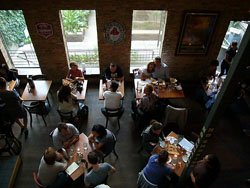 Not only does Hopleaf offer a most impressive array of beer, but they also offer an excellent menu of Belgian food. The dining room can be found up the ramp, past the bookcase in the front room. There you’ll find a number of low-slung wooden tables within a high-ceilinged vault of exposed brick and long plate glass windows. The steamed mussels are the stand-out at Hopleaf. I once worked with a Walloon (French Belgian) who has great taste in food and he claimed Hopleaf’s mussels to be the best you can find in Chicago. To my mind this “official” Belgian certification is tough to beat but, as the Chicago Bites girls point out, make sure you order extra bread up front! The best part about Hopleaf’s mussels is dipping your French bread into the beer broth. In addition to the mussels, I’ve personally had the steak frites several times (hanger steak served with thinly cut french fries), and it is excellent – as good as I’ve had at Le Bouchon, my favorite French restaurant in the city. The Chicago Bites girls also point out, with myself in agreement, that the beef stew is very good (even with brussels sprouts) and the “CB&J” (cashew, butter & jelly sandwich) was surprisingly savory and good, but the carrot cake and apple fritter desserts were lacking in taste and a disappointment in general. While the dining room is the best spot to enjoy your meal, food is also served in the main barroom. The fare at Hopleaf is excellent for any pub, particularly when combined with a selection of the Belgian ale, so don’t be surprised if there’s a two-hour wait during primetime on the weekends. My advice: get there early on weekends (before 7pm) or head over to Hopleaf during the week. Though Manhattan’s Spotted Pig claims to be the first gastropub in the U.S., Hopleaf predates it by at least six months having opened their kitchen in 2003.
Not only does Hopleaf offer a most impressive array of beer, but they also offer an excellent menu of Belgian food. The dining room can be found up the ramp, past the bookcase in the front room. There you’ll find a number of low-slung wooden tables within a high-ceilinged vault of exposed brick and long plate glass windows. The steamed mussels are the stand-out at Hopleaf. I once worked with a Walloon (French Belgian) who has great taste in food and he claimed Hopleaf’s mussels to be the best you can find in Chicago. To my mind this “official” Belgian certification is tough to beat but, as the Chicago Bites girls point out, make sure you order extra bread up front! The best part about Hopleaf’s mussels is dipping your French bread into the beer broth. In addition to the mussels, I’ve personally had the steak frites several times (hanger steak served with thinly cut french fries), and it is excellent – as good as I’ve had at Le Bouchon, my favorite French restaurant in the city. The Chicago Bites girls also point out, with myself in agreement, that the beef stew is very good (even with brussels sprouts) and the “CB&J” (cashew, butter & jelly sandwich) was surprisingly savory and good, but the carrot cake and apple fritter desserts were lacking in taste and a disappointment in general. While the dining room is the best spot to enjoy your meal, food is also served in the main barroom. The fare at Hopleaf is excellent for any pub, particularly when combined with a selection of the Belgian ale, so don’t be surprised if there’s a two-hour wait during primetime on the weekends. My advice: get there early on weekends (before 7pm) or head over to Hopleaf during the week. Though Manhattan’s Spotted Pig claims to be the first gastropub in the U.S., Hopleaf predates it by at least six months having opened their kitchen in 2003.
Photos courtesy of Tammy Green of Chicago Bites
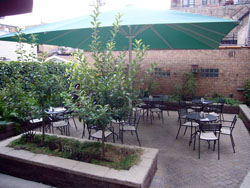 While weekdays can be pretty quiet, weekends at the Hopleaf can get a bit claustrophobic. The beer garden (accessible through the dining room) offers leafy tranquility in summer and the room upstairs offers additional space but is quite small, with a very narrow hallway and only a few tables, and does not offer any of the beer on tap. The crowd at Hopleaf consists mainly of mellow neighborhood types, ranging in age from late twenties to middle age. Hopleaf promotes itself as friendly but many, including myself, have found the atmosphere to be a tad pretentious in a Wicker Park sort of way. Patrons are often local theater types, beer connoisseurs, musicians, older neighborhood couples (LGBTQ+ and straight), and those venturing in from outside the area – the types that Andersonville-ites fear will overrun their little treasure. However, this shouldn’t bother you as you explore the drinks menu and enjoy the tunes. Think of Hopleaf as a Caribou Coffee with beer and sans fireplace.
While weekdays can be pretty quiet, weekends at the Hopleaf can get a bit claustrophobic. The beer garden (accessible through the dining room) offers leafy tranquility in summer and the room upstairs offers additional space but is quite small, with a very narrow hallway and only a few tables, and does not offer any of the beer on tap. The crowd at Hopleaf consists mainly of mellow neighborhood types, ranging in age from late twenties to middle age. Hopleaf promotes itself as friendly but many, including myself, have found the atmosphere to be a tad pretentious in a Wicker Park sort of way. Patrons are often local theater types, beer connoisseurs, musicians, older neighborhood couples (LGBTQ+ and straight), and those venturing in from outside the area – the types that Andersonville-ites fear will overrun their little treasure. However, this shouldn’t bother you as you explore the drinks menu and enjoy the tunes. Think of Hopleaf as a Caribou Coffee with beer and sans fireplace.
 Hopleaf is located in the heart of Andersonville, the Swedish capital of Chicago. Prior to the Hopleaf, the building was operated as Clark Foster Liquors (specifically because of its proximity to that intersection), by owner, Hans Gotling. Hans is a big part of why the neighborhood is called Andersonville in the first place, as it is officially part of the Edgewater neighborhood. To combat the urban decay of the 1960s, Hans, as 47th Ward precinct captain together with the local chamber of commerce, created the area concept of “Andersonville,” named after the Swedish Andersonville School, run by Reverend Anderson. Andersonville was a way to celebrate their Swedish ancestry and to bring a renewed sense of pride to an area that suffered from vacant lots and overall neglect. Within just a few years, Andersonville blossomed and is now one of the more sought after residential neighborhoods in the city. In addition, Hans was well known for making homemade glogg—made from a combination of port wine blended with raisins, aquavit (Swedish vodka) and other spices, served hot and too good not to try. Sadly, Hans joined his Viking ancestors in December 2006, but his glogg tradition lives on at Hopleaf.
Hopleaf is located in the heart of Andersonville, the Swedish capital of Chicago. Prior to the Hopleaf, the building was operated as Clark Foster Liquors (specifically because of its proximity to that intersection), by owner, Hans Gotling. Hans is a big part of why the neighborhood is called Andersonville in the first place, as it is officially part of the Edgewater neighborhood. To combat the urban decay of the 1960s, Hans, as 47th Ward precinct captain together with the local chamber of commerce, created the area concept of “Andersonville,” named after the Swedish Andersonville School, run by Reverend Anderson. Andersonville was a way to celebrate their Swedish ancestry and to bring a renewed sense of pride to an area that suffered from vacant lots and overall neglect. Within just a few years, Andersonville blossomed and is now one of the more sought after residential neighborhoods in the city. In addition, Hans was well known for making homemade glogg—made from a combination of port wine blended with raisins, aquavit (Swedish vodka) and other spices, served hot and too good not to try. Sadly, Hans joined his Viking ancestors in December 2006, but his glogg tradition lives on at Hopleaf.
 Photo courtesy of Drinking & Writing Brewery
Photo courtesy of Drinking & Writing Brewery
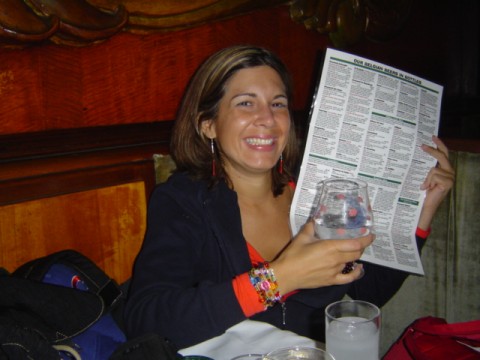 Hopleaf is one of my favorite bars as it stands out for its relaxed vibe and is a paradise for beer lovers. Hopleaf was even one of only 12 bars in Chicago rated Four Mugs (highest) by The Official Chicago Bar Guide in 2001 and was ranked “Top Tavern” nationally by All About Beer. I would especially recommend the Hopleaf, both before and after, a viewing of Too Much Light Makes the Baby Go Blind (TMLMTBGB), which is a 15-year old, ever changing comedic masterpiece put on by the Neo Futurists (located on the southeast corner of Foster and Ashland, just above the Nelson Funeral Home). Just don’t expect the locals to welcome you with open arms. For more information, check out the Hopleaf Bar website. Aviva!
Hopleaf is one of my favorite bars as it stands out for its relaxed vibe and is a paradise for beer lovers. Hopleaf was even one of only 12 bars in Chicago rated Four Mugs (highest) by The Official Chicago Bar Guide in 2001 and was ranked “Top Tavern” nationally by All About Beer. I would especially recommend the Hopleaf, both before and after, a viewing of Too Much Light Makes the Baby Go Blind (TMLMTBGB), which is a 15-year old, ever changing comedic masterpiece put on by the Neo Futurists (located on the southeast corner of Foster and Ashland, just above the Nelson Funeral Home). Just don’t expect the locals to welcome you with open arms. For more information, check out the Hopleaf Bar website. Aviva!
